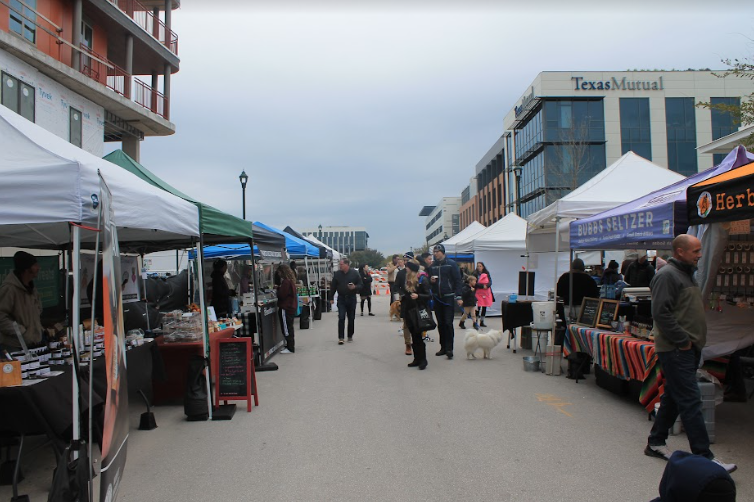The Fun In Farmers Markets
Funky, fun, fresh, and facinating foods and goods
FRESHLY FARMED: Simple Promise Farms hosted a tent at the Texas Farmers’ Market at Mueller on Nov. 13. SImple Promise sells vegetables and pickled goods, with the goal of assisting people recovering from addiction. photo by Zia Harvey
December 19, 2022
Farmers markets across Austin have been producing fresh produce, new flavors, and hosting community gatherings since 1987, with the Barton Creek Farmers Market. Now known as one of the longest running farmers markets in the country, according to their website – more farmers markets have appeared around Austin, in locations such as Mueller’s Town Center and Lakeline Mall, open every Saturday from 9 a.m. to 1 p.m., and the Mueller Farmers Market is open every Sunday from 10 a.m. to 2 p.m.
Jason Ellis is a local business owner and participates in the Mueller Farmers Market every week, at his yaupon holly tea stand. Ellis has been with the market for years and is familiar with what it takes to both be a vendor and an active member of the community.
“Access to local foods keeps a lot of the money in the local community,” Ellis said. “When you’re buying stuff from the farmers, it’s going back to the farmers, and then they usually end up spending in the community instead of buying something at Walmart…Who knows where that money goes. That’s one of the big things economically.”
Vendors can grow and source products from multiple farmers, as is the case with the Boggy Creek Farms stand. For the last seven and a half years, Safar Arafat-Ray has been a market coordinator and volunteer at Boggy Creek Farms, a farm founded nearly two centuries ago in 1841.
“Farmers markets and stands are key to not only highlighting local growers and artisans, but they introduce the local community to new, seasonal, and in most cases, better, fresher produce and products than they would find at the local grocery store,” Arafat-Ray said. “The markets also create a sense of community and connection with the growers that face-to-face interaction provides.”
Farmers markets bring in a variety of products that are uncommon and unfamiliar to the population, and introduce ideas such as incorporating seasonal fruits and vegetables into meals, which isn’t a concern in stores that stock the same produce year-round. Arafat-Ray says exposure to new produce is something that Boggy Creek Farms achieves by bringing in different products during different times of the year.
“The best moments come when you see customers excited by what we have to offer,” Arafat-Ray said. “Some are excited for beans in spring, some for tomatoes in summer, others with greens in autumn, others still beets and carrots in winter.”
Farmers markets offer a wide array of food according to Arafat-Ray. This gives people a chance to both support local farmers but also try local produce that may not be available in traditional grocery stores and find new things they might really like.
“When a customer has been educated about and is interested to try something they’ve never eaten or seen before – be it a foraged native green like Purslane or Lamb’s Quarter, a squash like Kobocha, Daesene Green Eggplant, Rainbow Radishes, Harukai Turnips, or even Asian Long Beans, the next time they come into the farm stand and tell us how much they enjoyed their new find helps us feel like we’ve done our jobs,” Arafat-Ray said.
According to Ellis, owning a stand at a farmers market is no easy task, farmers and business owners face unique experiences and challenges on a daily basis. Whether it’s troublesome customers or tight schedules, overcoming these obstacles can take a toll on business at the market.
“It’s a lot of work,” Ellis said. “It’s the best market in Austin too, so they’re pretty selective on who gets in here. I woke up at 5:30 this morning and the market didn’t start until 10. By the time I’m home and unloaded, it’s five o’clock already.”
Offering a diverse range of produce at multiple different farmers markets is another challenge that requires coordination and the ability to plan ahead, according to Arafat-Ray. Afart-Ray also said that themselves, as well as other Boggy Creek Farms employees have learned how to be able to problem solve and overcome conditions out of their hands.
“In a larger market, there are always the tasks of coordinating vendors, assigning volunteers and staff to certain tasks, setting up and breaking down the market, accounting systems, dealing with the weather, crowd control, security, and arranging payment,” Arafat-Ray said. “In a farm stand, like at Boggy Creek, we deal with many of these issues as well, just on a smaller scale. The biggest challenge comes from the weather since it’s the one thing we can’t control. An early or prolonged freeze or extreme prolonged heat & drought can wipe out a field full of crops in a matter of just a few hours to a few days. With climate change, we, and other farmers, will continue to face uncertain weather patterns far more frequently than in the past.”
According to Arafat-Ray, with increased concerns regarding climate, extreme weather, and land usage, vendors have to persevere in order to continue providing for their customers. Arafat-Ray said that farmers across the country face the challenge of preserving the local food and craft culture in their communities. Junior Ana Garfield works at local farm program Urban Roots, which employs high schoolers in an agricultural setting, and has experience with farmers markets.
“Seasonal and local produce is important because it provides variety to people’s diets,” Garfield said. “Local produce is especially important as it is more fresh than what you would find at a supermarket, even if it is organic. The average vegetable travels thousands of miles before reaching your table, which is quite odd if you think about it. Seasonal and local produce allow people to feel more connected with their local culture.”









